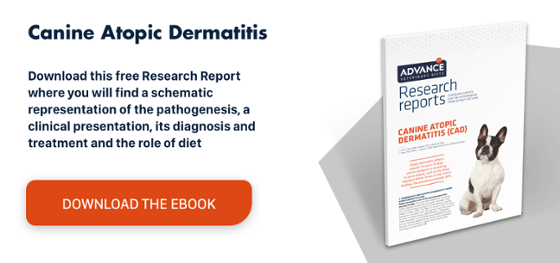Scabs in dogs: what are the most common causes?
Scabs in dogs are a frequent dermatological finding that are secondary to other underlying conditions. Scabs are formed from hardened scales on the surface of the skin that usually act as a protective barrier. They are a product of the wound healing process or keratinisation disorders, although the latter are much less common.
Parasites
External parasites are one of the main causes of scabs in dogs. Most cases are due to flea bites. In fact, some dogs may be very sensitive and develop flea allergy dermatitis, which means they do not even need to be infested for the clinical signs to manifest.
In such cases, small bumps usually appear near the bite, accompanied by redness and pruritus. Scabs develop once the patient starts scratching the lesions.
Notwithstanding, several other parasites can also cause scabs. Canine demodicosis caused, for example, by the over-proliferation of mites in the Demodex genus can also occur with small nodules, follicular plugs, flaking, seborrhoeic conditions, pustules, comedones, ulcers and scabs, as explained in this article by Eduard Saló, a Full Member of the European Society of Veterinary Dermatology.1
Allergens
The canine immune system, as with humans, sometimes recognises certain substances as foreign and overreacts. Two of the most common allergens are pollen and grasses, but there are many more. While any dog may have an allergy, some are more predisposed, such as brachycephalic breeds, terriers, setters and retrievers.
When exposed to the allergen, the dog will develop allergic dermatitis, which usually courses with pruritus, alopecia and skin redness. Persistent itching impels the dog to lick, bite and scratch the area, causing scabs to appear and increasing the risk of secondary bacterial or fungal infections.
Inadequate diet
Food allergens are also a common cause of scabs in dogs, a problem that usually occurs at an early age of between 6 months and 2 years. Food-induced skin reactions develop following the ingestion of one or more ingredients that trigger a food hypersensitivity reaction in the animal.
A study published by Ralf S. Mueller, Thierry Olivry and Pascal Prélaud2 concluded that the most common food allergens responsible for adverse dermatological reactions in dogs are beef, dairy products, chicken and wheat. They can cause vomiting and diarrhoea, but sometimes they only cause a pruritic reaction, prompting the excessive scratching that damages the animal’s skin. Therefore, when faced with a dog with nonspecific pruritus, it is advisable to test a diet specifically formulated for digestive and skin sensitivity.
Excessive bathing
Dogs without any skin problems should only be bathed once a month. Depending on the breed and lifestyle, the frequency could be even less. As a general rule, bathing dogs every week is too often and can end up damaging their skin and coat.
Hygiene products can dry out the animal’s skin and deplete its natural oils, affecting the balance of the bacterial flora that protects it from dermatological diseases.
The only exception is for dogs with atopic dermatitis, as frequent baths following a suitable treatment regimen accelerate their recovery. They should be treated with a special shampoo, such as the Advance Atopic Shampoo, with an anti-irritant and calming effect that helps to restructure the epithelial barrier.
Diseases
Some autoimmune diseases can cause skin damage and scabs in dogs. Discoid lupus erythematosus, for example, is characterised by discolouration of the nose and the appearance of scabs that lead to deep ulcers. Canine pemphigus may also produce yellowish scabs when the pustules associated with the condition rupture. Leishmaniasis is also characterised by localised alopecia, thickening of the skin and the appearance of wounds and scabs.
Treatment of scabs in dogs
Scabs in dogs are usually a symptom of a primary condition, so this needs to be diagnosed before determining the most appropriate treatment. The diagnosis should include a physical examination, which may reveal the presence of external parasites, and other more precise tests, such as skin scrapings, bacterial or fungal culture, cytology, biopsy or allergy tests.
The recommended tests include an exclusion diet with Advance Hypoallergenic, which is especially formulated to reduce intolerances to ingredients and nutrients, so that any food sensitivities can be detected or ruled out in dogs with scabs or pruritus.


